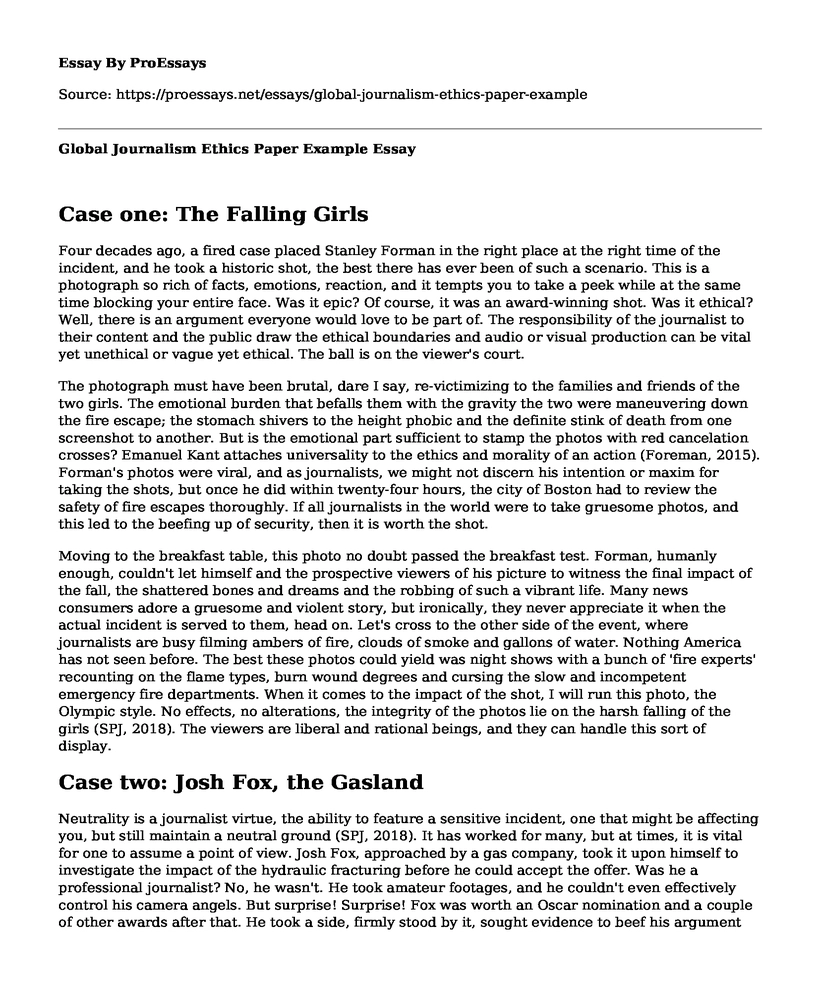Case one: The Falling Girls
Four decades ago, a fired case placed Stanley Forman in the right place at the right time of the incident, and he took a historic shot, the best there has ever been of such a scenario. This is a photograph so rich of facts, emotions, reaction, and it tempts you to take a peek while at the same time blocking your entire face. Was it epic? Of course, it was an award-winning shot. Was it ethical? Well, there is an argument everyone would love to be part of. The responsibility of the journalist to their content and the public draw the ethical boundaries and audio or visual production can be vital yet unethical or vague yet ethical. The ball is on the viewer's court.
The photograph must have been brutal, dare I say, re-victimizing to the families and friends of the two girls. The emotional burden that befalls them with the gravity the two were maneuvering down the fire escape; the stomach shivers to the height phobic and the definite stink of death from one screenshot to another. But is the emotional part sufficient to stamp the photos with red cancelation crosses? Emanuel Kant attaches universality to the ethics and morality of an action (Foreman, 2015). Forman's photos were viral, and as journalists, we might not discern his intention or maxim for taking the shots, but once he did within twenty-four hours, the city of Boston had to review the safety of fire escapes thoroughly. If all journalists in the world were to take gruesome photos, and this led to the beefing up of security, then it is worth the shot.
Moving to the breakfast table, this photo no doubt passed the breakfast test. Forman, humanly enough, couldn't let himself and the prospective viewers of his picture to witness the final impact of the fall, the shattered bones and dreams and the robbing of such a vibrant life. Many news consumers adore a gruesome and violent story, but ironically, they never appreciate it when the actual incident is served to them, head on. Let's cross to the other side of the event, where journalists are busy filming ambers of fire, clouds of smoke and gallons of water. Nothing America has not seen before. The best these photos could yield was night shows with a bunch of 'fire experts' recounting on the flame types, burn wound degrees and cursing the slow and incompetent emergency fire departments. When it comes to the impact of the shot, I will run this photo, the Olympic style. No effects, no alterations, the integrity of the photos lie on the harsh falling of the girls (SPJ, 2018). The viewers are liberal and rational beings, and they can handle this sort of display.
Case two: Josh Fox, the Gasland
Neutrality is a journalist virtue, the ability to feature a sensitive incident, one that might be affecting you, but still maintain a neutral ground (SPJ, 2018). It has worked for many, but at times, it is vital for one to assume a point of view. Josh Fox, approached by a gas company, took it upon himself to investigate the impact of the hydraulic fracturing before he could accept the offer. Was he a professional journalist? No, he wasn't. He took amateur footages, and he couldn't even effectively control his camera angels. But surprise! Surprise! Fox was worth an Oscar nomination and a couple of other awards after that. He took a side, firmly stood by it, sought evidence to beef his argument up and finally came up with an anti-fracking campaign through his documentary Gasland. He was never a certified journalist, but that didn't matter.
Newsfeed, news alerts, and news bits are often flooded with acts of violence, children injustices, war, and journalist act like the video recorders they use, with no say to the happenings whatsoever (Ward, 2018). For one to take that extra step, go that extra mile, reveal that additional detail that many missed, and that could ultimately turn the story around, a journalist must take sides, they must make it personal for a change. Of course, the impartial point of view is also an option, and it all depends on the sensitivity and extensity of the issue at hand. Journalism or mass media, like any other fields, is governed by multiple rules laws or theories that work harmoniously or sometimes contradict. The point of view must align with the ethical codes of journalism, and the journalist must present fact, no matter their important perspectives.
References
Foreman, Gene (2015). The Ethical Journalist: Making Responsible Decisions in the Digital Age. United States: John Wiley & Sons. p. 354
Society of professional journalists (2018). Code of ethics. https://www.spj.org/ethicsweek.aspWard, Stephen (March 5, 2018). "Philosophical Foundations for Global Journalism Ethics." Journal of Mass Media Ethics. 20: 3-21 https://doi.org/10.1207/s15327728jmme2001_2
Cite this page
Global Journalism Ethics Paper Example. (2022, Jun 17). Retrieved from https://proessays.net/essays/global-journalism-ethics-paper-example
If you are the original author of this essay and no longer wish to have it published on the ProEssays website, please click below to request its removal:
- Workers in the Cane Essay
- What Attracts Young People to a Career in Business? Essay Example
- Effective Pre-departure Training Paper Example
- Essay Example on Training: Developing Skills to Meet Job Requirements
- Paper Example on Healthcare Professionals: Code of Ethics for Optimal Performance
- AI: Unlocking Human Potential Through Machine Development
- Essay Example on Psychology: APA Code of Ethics & Moral Obligations







